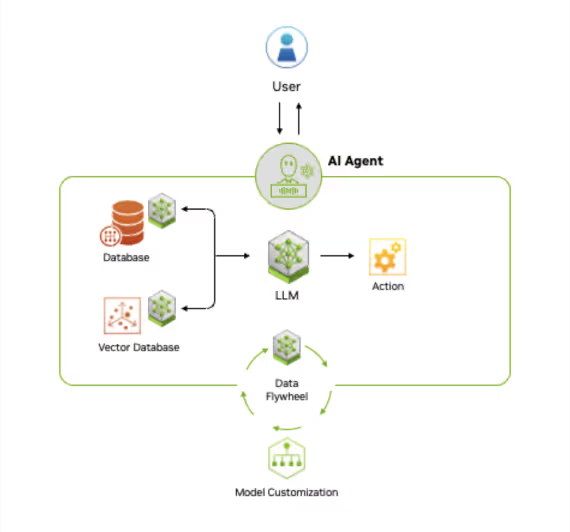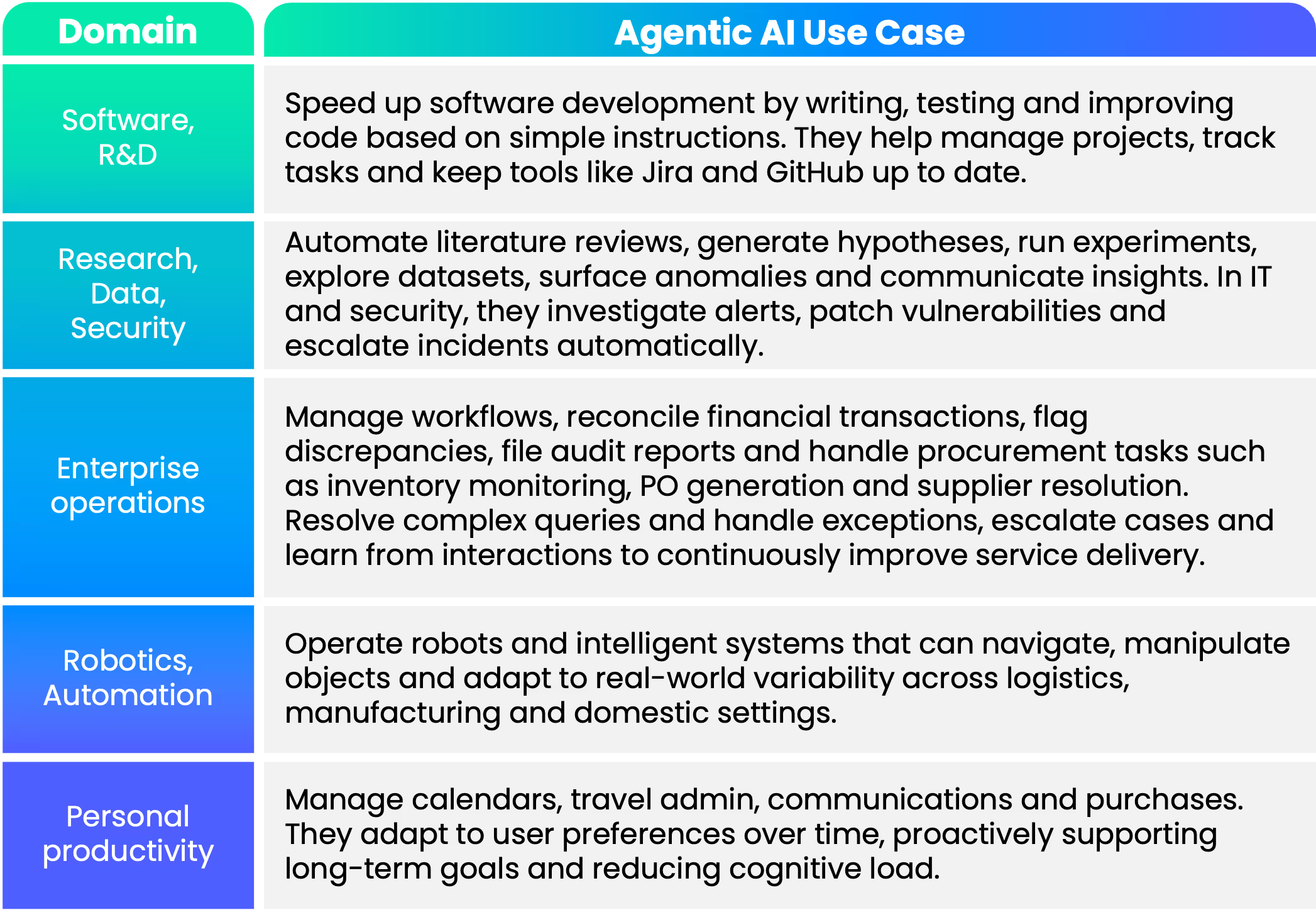

Read Time:
8
Minutes
September 22, 2025
Agentic AI: The Future of Workflow Efficiency and Autonomous Systems
The pace of innovation is staggering and continues to accelerate. Just a year ago, retrieval-augmented generation (RAG) was considered cutting edge. Today, it is largely viewed as a baseline capability. In conversations with AI thought leaders like Jim Spohrer, it becomes clear that AI is not only advancing rapidly but also driving the acceleration of its own evolution.
Artificial Intelligence (AI) is now at the heart of almost all the technology coming out of Silicon Valley. As we see from all of the AI tooling available to us at a personal level, making use of AI is no longer the realm of a few mathematical/programming masterminds, but a commodity item whose use is completely democratised by companies like OpenAI and Nvidia and the open-source community. The most advanced models are available to all, albeit predominantly for a fee, and have enabled a massive surge of AI enabled or AI service businesses across Silicon Valley and the world. The common joke across the SVTS Venture Capital firms this year being, “have you heard about this AI thing?”.
So, what is next? Well, the clear theme from this year’s SVTS was agentic AI. Of the 26 companies we engaged with, only four weren't directly delivering, utilising or supporting AI and Autonomy and three of those were providing foundations to build AI upon such as data management and quantum computing. Of those 22 companies, half are delivering agentic AI solutions.
What is Agentic AI?
Agentic AI refers to AI systems that are endowed with agency, i.e., the ability to act autonomously towards goals with minimal human intervention. Simply put, Agentic AI doesn’t just provide a response to a prompt like a standard LLM; it uses goal-oriented behaviour to take initiative and build and orchestrate a set of actions to deliver an output. For example, agentic AI can schedule meetings, reorder supplies, perform security incident response and even interact directly with existing/legacy applications as a human would, all based on a natural language prompt.
Crucially, agentic AI represents a shift from reactive tools to proactive collaborators. These systems can reason, plan, adapt, and engage over extended interactions, making them not just assistants, but strategic partners in business operations. As enterprises look beyond productivity gains to full-scale digital transformation, agentic AI is quickly becoming the next major inflexion point.
How does it work?
Agentic AI systems operate in a sense-think-act or plan-act-reflect loop. They first consider a problem, perceive inputs from their environment, decide on a plan of action, execute those actions and then observe the results to inform the next iteration of the loop. This allows an agentic AI to work step-by-step toward its objectives, rather than completing tasks in one shot, utilising memory and observation to meet its goal.
Modern agentic AI solutions generally leverage LLMs to act as the ‘brain’ to provide reasoning and planning. Techniques like the ReAct framework(Yao et al., 2023) combine reasoning and action in an LLM prompt, prompting the model to think step-by-step and decide on tool use. External modules or scripts then execute the chosen actions (like searching the web or running code) and feed the results back to the model. This creates a feedback loop where the LLM’s thought process guides and orchestrates agent behaviours and actions, in a similar way to how humans approach tasks iteratively.

(Image source: www.blogs.nvidia.com/blog/what-is-agentic-ai/)
What can Agentic AI be used for?
Agentic AI is transforming business functions by combining autonomy, contextual awareness and adaptive learning. These systems execute complex tasks with minimal oversight, streamlining workflows, improving responsiveness and reducing manual effort across diverse domains:

The role of the model context protocol in scaling agentic AI?
As agentic AI rapidly matures, systems are gaining the ability to perform increasingly complex, multi-step tasks with minimal human input. A major milestone in this evolution is the emergence of multi-agent systems, where 'manager' agents coordinate networks of specialised agents. This orchestration is made feasible through emerging standards like the model context protocol (MCP).
Developed by Anthropic and open-sourced in late 2024, MCP provides a universal framework for interoperability across agents, models, tools and data sources. It enables diverse components to collaborate on bespoke tasks by structuring how context (such as goals, interaction history, state and tool outputs) is represented and shared.
In agentic systems, continuity and contextual coherence are critical. Unlike traditional prompt-response models, agentic AI must operate over time, track evolving goals and make informed decisions based on prior actions. MCP ensures context is persistently maintained, eliminating the need to redundantly include full histories with every input. Therefore, greatly improving efficiency and resilience.
This structure underpins reliable decision-making, enabling agents to reason, plan and act consistently in dynamic environments and in multi-agent or modular architectures. MCP standardises context exchange across components such as planning engines, reasoning modules and execution tools. This ensures coordinated, goal-aligned behaviour.
Furthermore, MCP enhances integration with external tools and APIs, enabling agents to reason over tool outputs and take appropriate next steps. It also boosts transparency and de-buggability. By externalising context, system operators can trace what an agent knows, intends and has done. This is critical for safety, trust and compliance.
By streamlining context management, MCP improves scalability, reduces redundancy and supports distributed systems. Ultimately, it transforms AI from reactive assistants into persistent, proactive collaborators. This makes it a foundational enabler for the next generation of intelligent, autonomous systems.
Conclusion
Agentic AI is no longer a speculative concept. It is operational and rapidly scaling. Today’s intelligent digital agents re already relieving professionals of repetitive, time-consuming tasks, acting as tireless co-pilots across functions. But this is just the beginning.
As these systems become more capable, interconnected and autonomous, we are approaching a fundamental shift in how work is defined and value is created. Businesses that embrace agentic AI early will not only achieve greater efficiency but will also unlock new levels of productivity, creativity and decision-making. Leaders must think beyond automation and consider how to redesign workflows, roles and even strategy around intelligent collaboration between humans and machines.
The future of work will be less about task execution and more about outcome orchestration. Agentic AI makes this possible by freeing human capacity for innovation, complex judgement and more meaningful engagement. Those who prioritise understanding and implementation today will be the ones leading the intelligent enterprises of tomorrow.
Authored by: Richard Hextall, Managing CyberSecurity Consultant at Actica Consulting
If you enjoyed this blog post, explore these related topics from Ntegra's Blog Hub for deep insights, industry trends, and thought leadership. Our curated content navigates the ever-evolving landscape of technology, innovation, and business strategy.
Building an AI-Ready Organisation: Insights from March Roundtable
Navigating AI Transformation: Lessons from Industry Leaders in 2025
Figma Config 2025: AI Design Tools for Agile Innovation
Becoming AI-First: Unlock Strategic Value with Confidence and Trust
Enhancing AI with Precision: The Evolution and Impact of Retrieval-Augmented Generation
Understanding AI-Powered Virtual Assistants: Building, Benefits, Risks and Selection
2025 Innovation Predictions: The Future of Technology and Disruption
Tech Roundup: How Apple, Google and Microsoft Are Engineering the Next Phase of AI
Ntegra's Innovation and Technology Predictions for 2024
USRT 2018 – The Future Of AI – Jim Spohrer
Digital Transformation: Turning Artificial Intelligence Investment into Lasting Competitive Edge

